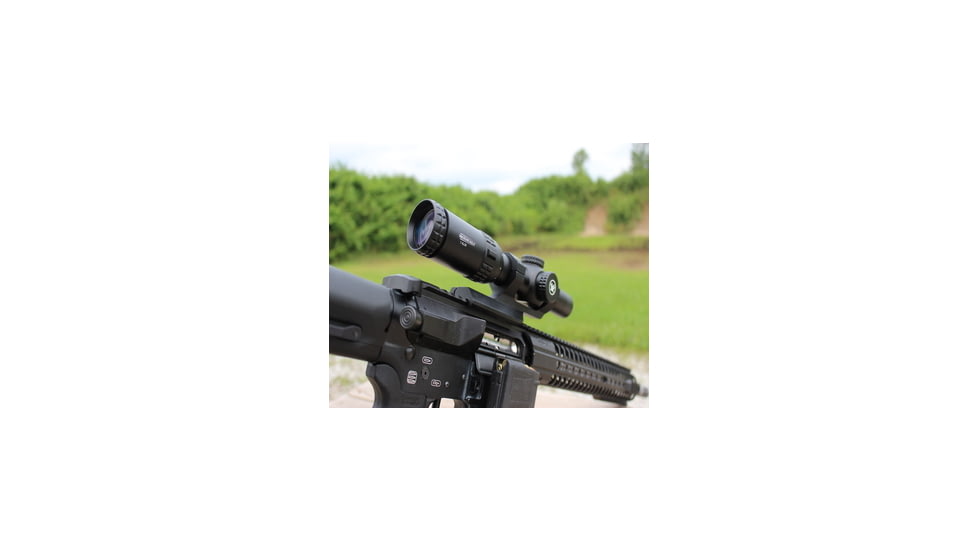LPVO stands for Low-Powered Variable Optic. Most LPVO scopes start at true 1x (no magnification) and typically go as high as 10x. However, 1-4x, 1-6x, and 1-8x are the most popular magnification ranges you’ll find for these rifle scopes. Keep reading to learn more about LPVO optics, why they are the most common AR15 scope, how they differ from red dots, and why you should consider buying one for your rifle build.![]()
What Are the Benefits of an LPVO?
LPVO scopes have lower magnification ranges, which assists with quick target acquisition, especially at short to mid-range distances. Most LPVOs are optimal anywhere from point blank to the 300-500 yard range mark, but a quick dial can get you out to 800 yards in a pinch. Unlike high-power rifle scopes commonly used for benchrest competitions, LPVOs excel in CQB situations at 1x magnification.
The best reason to buy an LPVO is versatility. With a high-quality throw lever, you can quickly change magnifications to meet your demands in the field. That’s why they are so popular among the military and tactical crowd – they excel at both clearing corners and honing in on distant targets. You don’t get that speed and movement with higher powered optics, and red dot sights don’t provide marksmen with the option to quickly zoom in on long-range objects with a precise reticle. Speaking of which, let’s break down one of the most commonly asked questions regarding low power variable optics below.
LPVO vs. Red Dot Sight
A lot of AR owners can’t decide between an LPVO or red dot sight for close-range shooting. However, the decision is simpler than you think. Red dot optics, like reflex sights and holographic sights, are the ideal choice if you only plan on close-range engagements. Red dots are smaller and instantly provide an easy sight picture to acquire. They are also lighter and more maneuverable than an LPVO at 1x.
Sure, you can add a red dot magnifier to your setup to quickly swap to 3x or 5x magnification, but your reticle is still that same red dot. On the other hand, LPVO scopes have a finer reticle that won’t cover your entire target, making it easier to see your target at longer distances, where a red dot will cover most of it. If you’re looking for speed and precision, go with a red dot sight, but if you plan on encountering targets at a variety of distances, an LPVO will give a more accurate and cleaner sight picture.
That’s why LPVO scopes are the preferred AR15 optic choice for 3-gun competitions, where target distances vary frequently and speed is essential. You may encounter a close-range target and then a target a few hundred yards out. An LPVO allows you to not only quickly adjust to your desired magnification, but you’ll have a much more precise reticle to ensure you nail your shots. You’ll have a much harder time hitting distant targets accurately with a large red dot reticle covering that target 300 yards out.
Another benefit of LPVOs is that they have an etched reticle. If your red dot runs out of battery or experiences failure, that’s the end of a line, but even an LPVO with an illuminated reticle will still provide a solid aiming point without requiring any batteries or external power sources.
Can You Keep Both Eyes Open with an LPVO?
Yes, you can shoot an LPVO with both eyes open, especially at 1x magnification. This provides ample situational awareness, which is essential for military and tactical uses. Plus, both-eyes-open shooting helps reduce eye fatigue, helping you stay concentrated and comfortable during extended shooting sessions.
Do You Need to Zero an LPVO?
Yes, much like a traditional rifle scope, you need to zero your LPVO optic. Zeroing a scope ensures that your point of aim matches your point of impact. Read our comprehensive guide on How to Zero a Rifle Scope for a complete overview on the topic. Once you understand how to zero a scope, it’s simply a matter of figuring out how you intend to use your LPVO.
A 50/200 yard zero is one of the most popular choices for LPVOs because you can accurately aim at targets up to 250 yards out without adjusting your aim. It means your bullet’s point of impact and point of aim will align at both 50 yards and 200 yards. While you can zero your LPVO for 100 yards to hit targets beyond 300 yards, that’s not exactly the point of an LPVO. However, if you want to practice long-range shooting, go ahead and dial it in for longer distances. Just make sure to re-zero your scope if you want to optimize it for close to mid-range shooting.
The Lowdown on LPVOs
LPVO scopes are the perfect AR-15 optic for those who want speed and precision at close ranges with the ability to precisely hit distant targets at a moment’s notice. Need help choosing the best LPVO for your AR? Then check out our guide Best LPVO for the Money to find the perfect low-power variable optic based on your needs and budget. Shop online at OpticsPlanet today for amazing deals on Vortex LPVOs, Primary Arms LPVOs, SIG SAUER LPVOs, and other low-power variable optics from top brands in the industry.







